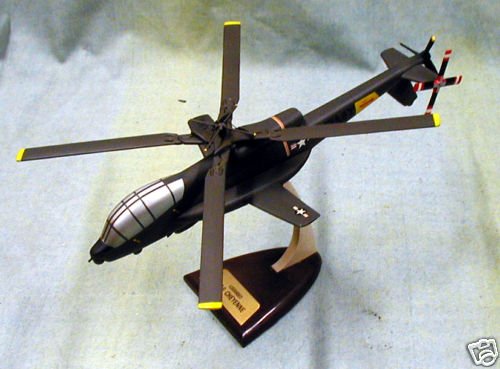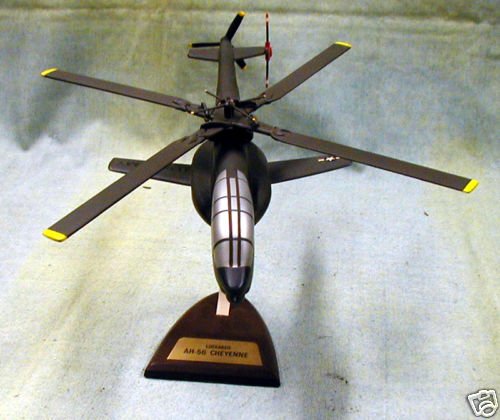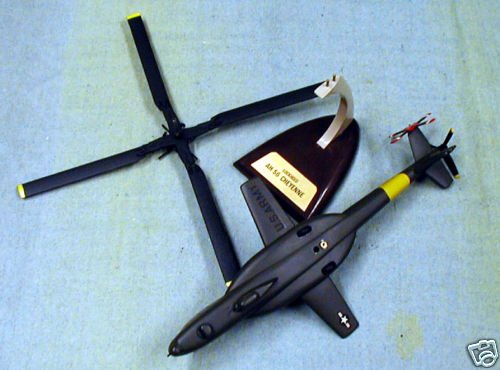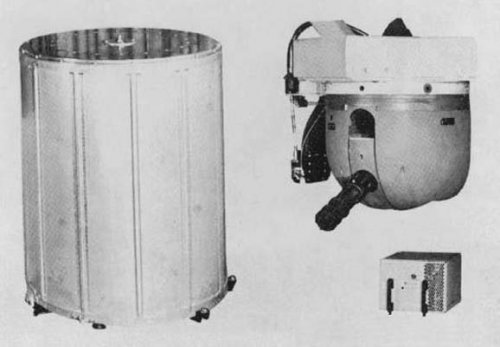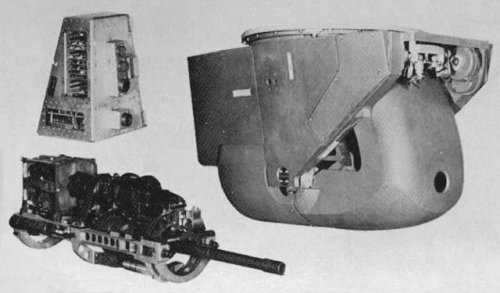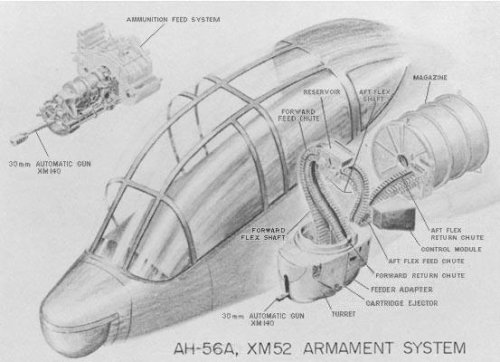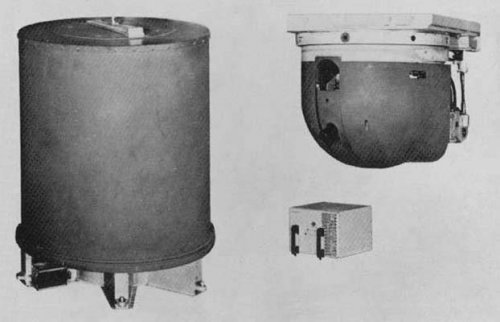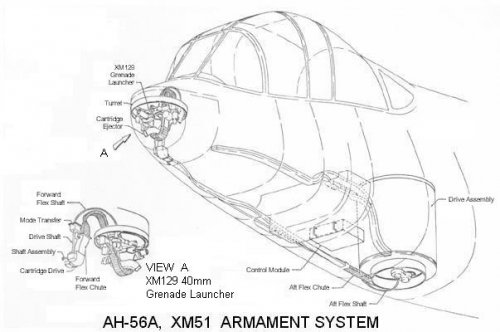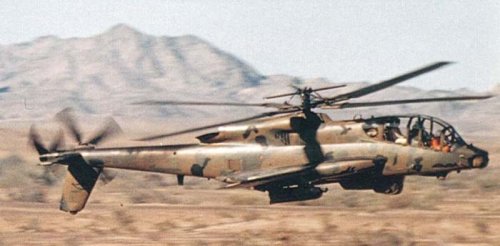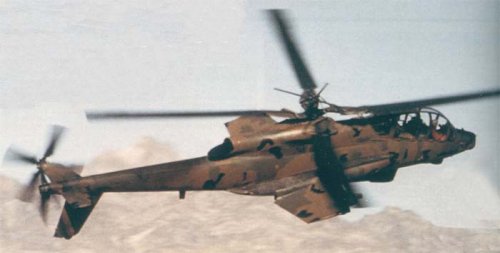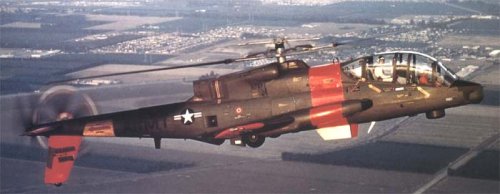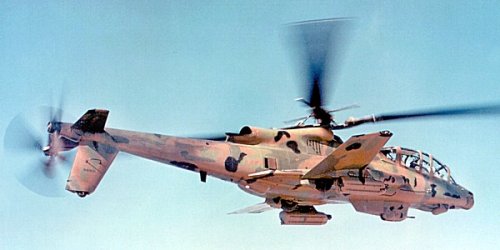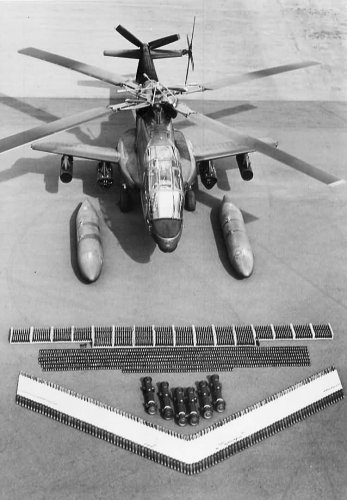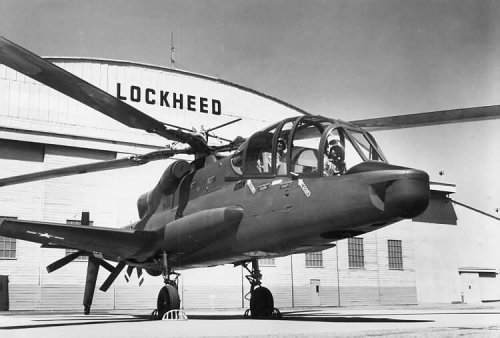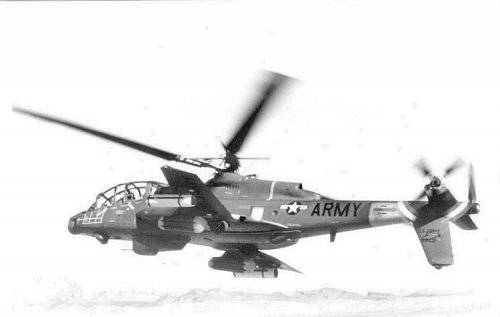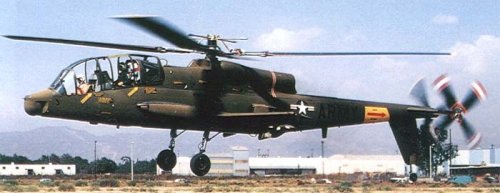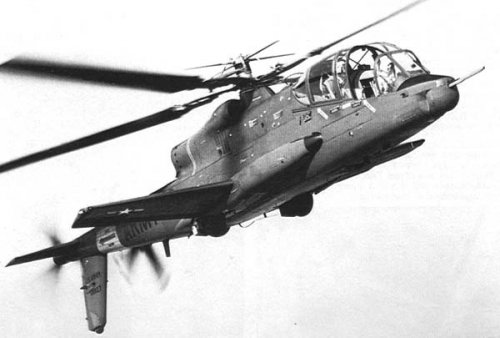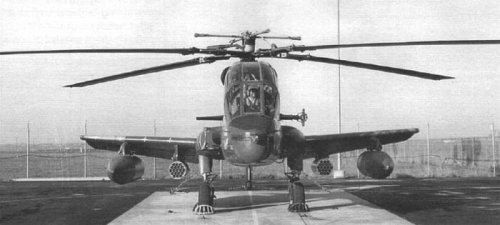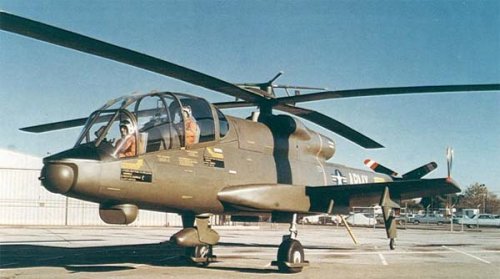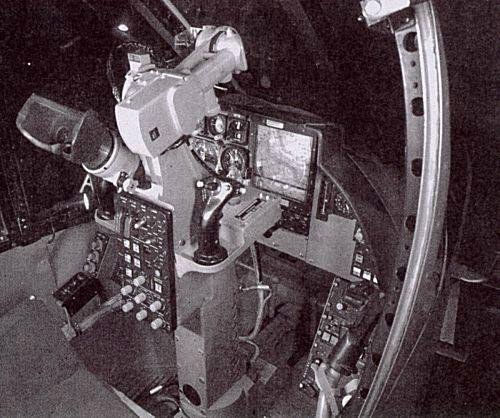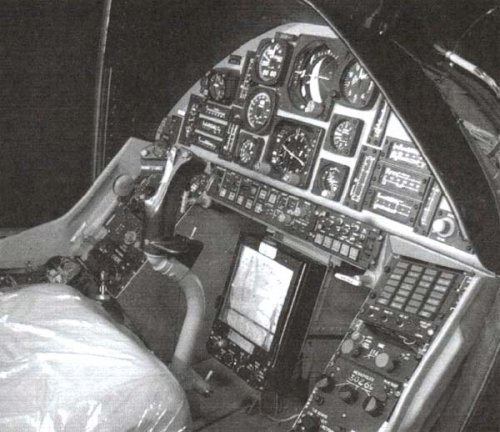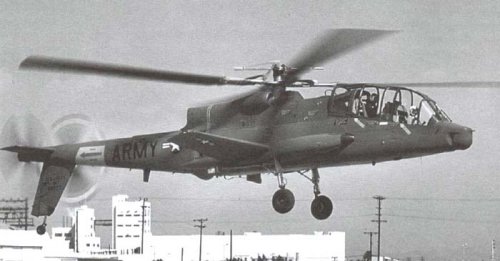I presume that the aircraft that started to look more attractive during development of the AH-56 Comanche were the Sikorsky S-67 Blackhawk and the Bell Model 309 Kingcobra?
You are using an out of date browser. It may not display this or other websites correctly.
You should upgrade or use an alternative browser.
You should upgrade or use an alternative browser.
Lockheed AH-56 Cheyenne and derivatives
- Thread starter Jemiba
- Start date
- Joined
- 18 October 2006
- Messages
- 4,203
- Reaction score
- 4,880
overscan said:The turf wars between the Army and USAF are an interesting topic in their own right. Could have seen the Northrop/Hawker Harrier in Army service.
There are a couple of books on this subject out there already (I'll try to post the relevant info when I find them). The turf war remains alive today....
saturncanuck
Any landing you can walk away from, is a good one.
Triton said:I presume that the aircraft that started to look more attractive during development of the AH-56 Comanche were the Sikorsky S-67 Blackhawk and the Bell Model 309 Kingcobra?
Actually, the S-67 and Bell 309 competed after the cancellation of the AH-56, but the US Army found them lacking and launched a new program, which eventually became the RAH-66. Which was also cancelled.
Don't think so. The "official successor" of the Cheyenne was the AH-64 Apache, started in 1972.
It was supposed to be less costly than the Cheyenne; in the end, the sole Apache avionic set was as expensive as a whole Cheyenne.
The Comanche had roots in the LHX, itself planned successor of the OH-58 Kiowa, which entered service in the late 70's. OH-58 are still flying as of today.
Footnote: I LOVE the AH-56 Cheyenne. What a machine... doomed from the start by crazy specifications. Le Fana de l'aviation, July-August 2000 edition, had a superb article crammed with photos and drawings. Highly recommended.
It was supposed to be less costly than the Cheyenne; in the end, the sole Apache avionic set was as expensive as a whole Cheyenne.
The Comanche had roots in the LHX, itself planned successor of the OH-58 Kiowa, which entered service in the late 70's. OH-58 are still flying as of today.
Footnote: I LOVE the AH-56 Cheyenne. What a machine... doomed from the start by crazy specifications. Le Fana de l'aviation, July-August 2000 edition, had a superb article crammed with photos and drawings. Highly recommended.
saturncanuck
Any landing you can walk away from, is a good one.
You're both right and wrong.
While the AAH program was the successor to the AAFSS program, both the S-67 and Bell 309 were evaluated by the US Army.
"In August 1972, the US Army cancelled the AH-56A program and they were without a new attack and close-support helicopter. As the Blackhawk had been flying successfully for two years by this point, Sikorsky was confident of a contract under the AAFSS Program. However, ten months earlier – in September 1971 – the Bell 309 KingCobra (q.v.) had made its first flight, and now there were two competitors to fill the void left by the cancellation of the AH-56A. Not wanting to be drawn again into a “paper” competition – as had been done on the Cheyenne program – the US Army opted to have a fly-off between the KingCobra and the Blackhawk. Thus, the two competing aircraft were flown against one another during September and October 1972. However, although both aircraft proved to be advanced and improvements over the AH-1 HueyCobra, the US Army opted not to choose either aircraft as they still required an aircraft of similar performance as the cancelled AH-56A, and neither aircraft matched this. As a result, in November 1972, the US Army set up a new program called the Advanced Attack Helicopter (AAH) program which produced the Bell YAH-63 (q.v.) and Hughes YAH-64 prototypes."
Excerpt from "Clipped Wings -- The History of Aborted Aircraft Projects", AeroFile Publications, November 2007, ISBN 978-0-9732020-4-5
While the AAH program was the successor to the AAFSS program, both the S-67 and Bell 309 were evaluated by the US Army.
"In August 1972, the US Army cancelled the AH-56A program and they were without a new attack and close-support helicopter. As the Blackhawk had been flying successfully for two years by this point, Sikorsky was confident of a contract under the AAFSS Program. However, ten months earlier – in September 1971 – the Bell 309 KingCobra (q.v.) had made its first flight, and now there were two competitors to fill the void left by the cancellation of the AH-56A. Not wanting to be drawn again into a “paper” competition – as had been done on the Cheyenne program – the US Army opted to have a fly-off between the KingCobra and the Blackhawk. Thus, the two competing aircraft were flown against one another during September and October 1972. However, although both aircraft proved to be advanced and improvements over the AH-1 HueyCobra, the US Army opted not to choose either aircraft as they still required an aircraft of similar performance as the cancelled AH-56A, and neither aircraft matched this. As a result, in November 1972, the US Army set up a new program called the Advanced Attack Helicopter (AAH) program which produced the Bell YAH-63 (q.v.) and Hughes YAH-64 prototypes."
Excerpt from "Clipped Wings -- The History of Aborted Aircraft Projects", AeroFile Publications, November 2007, ISBN 978-0-9732020-4-5
Archibald said:Don't think so. The "official successor" of the Cheyenne was the AH-64 Apache, started in 1972.
It was supposed to be less costly than the Cheyenne; in the end, the sole Apache avionic set was as expensive as a whole Cheyenne.
The Comanche had roots in the LHX, itself planned successor of the OH-58 Kiowa, which entered service in the late 70's. OH-58 are still flying as of today.
Footnote: I LOVE the AH-56 Cheyenne. What a machine... doomed from the start by crazy specifications. Le Fana de l'aviation, July-August 2000 edition, had a superb article crammed with photos and drawings. Highly recommended.
- Joined
- 18 March 2008
- Messages
- 3,529
- Reaction score
- 956
Archibald said:Footnote: I LOVE the AH-56 Cheyenne. What a machine... doomed from the start by crazy specifications. Le Fana de l'aviation, July-August 2000 edition, had a superb article crammed with photos and drawings. Highly recommended.
Just having read Air Enthusiast No. 108 (Nov/Dec 2003) with an article by Francis Allen it wasn't the spec that killed the AH-56 but the schedule. Lockheed made the high speed, ultra maneuverable helo work and work very well by the end of the program. It just took them until 1972 when the US Army needed a CH-47 escort helicopter in production by 1970.
The AH-56 would have been ideal in operations in Afghanistan and Iraq in the here and now (assuming they had the 1970s and 1990s systems of the AH-64A and AH-64D). Not even the WAH-64D is close to its flying performance. A real lost opportunity. Who knows what Lockheed could have brought with all that helicopter profit? Lockheed Martin McDonnell?
- Joined
- 18 March 2008
- Messages
- 3,529
- Reaction score
- 956
Not many of the online sources mention the ammunition capability of the AH-56A's weapon systems So I thought I would add them here:
XM51 Armament Subsystem
The XM51 was a Research and Development project for a flexible chin-mounting M129 40mm grenade launcher with 780 rounds of linked ammunition in a storage drum with associated ammunition chutes for use on the A H-56A Cheyenne. Sighting was accomplished using the XM110 helmet sight, XM112 swiveling gunner's station, or XM114 reflex sight.
XM52 Armament Subsystem
The XM52 was a Research and Development project for a belly turret for mounting an XM140 30mm automatic gun, with 2,010 rounds of linkless ammunition in a storage drum with conveyor, beneath the AH-56A Cheyenne. Sighting was accomplished using the XM110 helmet sight, XM112 swiveling gunner's station, or XM114 reflex sight.
XM53 Armament Subsystem
The XM53 was a Research and Development project for chin-mounting of an XM196 six-barrel,7.62mm "Minigun", with 11,570 rounds of linkless ammunition in a storage drum with conveyor, on the A H-56A Cheyenne The XM53 was an alternate to the XM51. Sighting was accomplished using the XM110 helmet sight, XM112 swiveling gunner's station, or XM114 reflex sight.
That's right: 11,570 rounds of 7.62x51mm (or 780 rounds of 40x53mm) and 2,010 rounds of 30x113mm! AH-64 only carries 1,200 rounds of 30x113mm...
http://tri.army.mil/LC/CS/csa/aawpns.htm
XM51 Armament Subsystem
The XM51 was a Research and Development project for a flexible chin-mounting M129 40mm grenade launcher with 780 rounds of linked ammunition in a storage drum with associated ammunition chutes for use on the A H-56A Cheyenne. Sighting was accomplished using the XM110 helmet sight, XM112 swiveling gunner's station, or XM114 reflex sight.
XM52 Armament Subsystem
The XM52 was a Research and Development project for a belly turret for mounting an XM140 30mm automatic gun, with 2,010 rounds of linkless ammunition in a storage drum with conveyor, beneath the AH-56A Cheyenne. Sighting was accomplished using the XM110 helmet sight, XM112 swiveling gunner's station, or XM114 reflex sight.
XM53 Armament Subsystem
The XM53 was a Research and Development project for chin-mounting of an XM196 six-barrel,7.62mm "Minigun", with 11,570 rounds of linkless ammunition in a storage drum with conveyor, on the A H-56A Cheyenne The XM53 was an alternate to the XM51. Sighting was accomplished using the XM110 helmet sight, XM112 swiveling gunner's station, or XM114 reflex sight.
That's right: 11,570 rounds of 7.62x51mm (or 780 rounds of 40x53mm) and 2,010 rounds of 30x113mm! AH-64 only carries 1,200 rounds of 30x113mm...
http://tri.army.mil/LC/CS/csa/aawpns.htm
- Joined
- 18 March 2008
- Messages
- 3,529
- Reaction score
- 956
sferrin said:Add to that the LARGE external load capacity.
While the AH-56's six weapons pylons were stressed for 2,000 lbs each such a maximum loadout would really cut into its range. One of the many great things about the AH-56 was its range (along with into, in and out of hover manoeuvrability and firepower). However like all helicopters weight has a huge impact on performance.
The standard loaded weight of an AH-56 was 18,300 lbs which with full internal fuel and EITHER a full load of shells and bullets (2,010 30x113 and 11,570 7.62x51mm) and the six TOWs OR the 76 2.75" HYDRA rockets. At 18,300 lbs and full internal fuel the AH-56 had a helicopter phenomenal range of three hours. Carrying the full standard weapons load would require a takeoff weight of 21,000 lbs (2,700 lbs over) and you would have at best an endurance of 2.5 hours.
At full external weapons load of 12,000 lbs the AH-56 could only carry 1,165 lbs of fuel (no shells and bullets) or 40% of a full tank at MTOW. At best this would mean an endurance of 45 minutes. Which may not sound so great but for a helicopter carrying six Mk 84 bombs is bloody amazing...
I find it hard to conceive how you can shoot 11,000 rounds from a minigun in a 2.5-3 hour mission. That’s one 50 round burst every 50 seconds! How do you find the targets! I’m sure Apache pilots over Afghanistan who end up shooting flares at the enemy because they can’t carry enough weapons in the hot and high would have loved the Cheyenne.
- Joined
- 3 June 2011
- Messages
- 18,298
- Reaction score
- 12,118
Lots of ammo, lots of speed, and lots of external fuel if it needed it. As I recall the two turrets could be operated independantly as well but I'd have to double check that. The Cheyenne is definitely towards the top of my list of favorite might-have-beens. I imagine Apache pilots might have liked the dual turrets when going after "squirters".
- Joined
- 18 March 2008
- Messages
- 3,529
- Reaction score
- 956
With full external fuel it had a ferry range of over 4,600km which is enough to cross the Atlantic if the weather was right. Which was strategically significant if the Soviets ever invaded West Germany. Being able to ferry your USA based attack helicopter force into Europe without the need for airlifters and all that entails (huge logistics burden) would enable NATO to massively and rapidly boost its anti-tank force.
The two turrets could engage separately with the gunner controlling one through his swivel seat and the pilot with the helmet mounted sight.
Considering the reason the AH-56 never entered production was the US Army was sold a design to cost AAH (which was bogus) and the endeavours of Hughes in illegally subverting the LOH contract... And had to wait ~15 years for the night capable attack helicopter the might-have-been AH-56 story is pretty soul destroying.
If the Cheyenne would have entered production I'm sure it would have ended up like the Chinook with multiple generations being built up until this day:
AH-56A
AH-56B USMC twin engine (real proposal)
HH-56C USN CSAR with 30mm replaced by ladder and cabin for two rescued pilots (real proposal)
AH-56D second generation with Hellfire, digital systems and twin engines
HH-56E second generation USN/USAF CSAR with single cockpit, winch and new cabin for two rescue operators, four rescued pilots
PH-56F USN sea control with surface search radar and Harpoon (real proposal for Apache)
AH-56G third generation with MMW radar, Longbow Hellfire
The two turrets could engage separately with the gunner controlling one through his swivel seat and the pilot with the helmet mounted sight.
Considering the reason the AH-56 never entered production was the US Army was sold a design to cost AAH (which was bogus) and the endeavours of Hughes in illegally subverting the LOH contract... And had to wait ~15 years for the night capable attack helicopter the might-have-been AH-56 story is pretty soul destroying.
If the Cheyenne would have entered production I'm sure it would have ended up like the Chinook with multiple generations being built up until this day:
AH-56A
AH-56B USMC twin engine (real proposal)
HH-56C USN CSAR with 30mm replaced by ladder and cabin for two rescued pilots (real proposal)
AH-56D second generation with Hellfire, digital systems and twin engines
HH-56E second generation USN/USAF CSAR with single cockpit, winch and new cabin for two rescue operators, four rescued pilots
PH-56F USN sea control with surface search radar and Harpoon (real proposal for Apache)
AH-56G third generation with MMW radar, Longbow Hellfire
Abraham Gubler said:With full external fuel it had a ferry range of over 4,600km which is enough to cross the Atlantic if the weather was right. Which was strategically significant if the Soviets ever invaded West Germany. Being able to ferry your USA based attack helicopter force into Europe without the need for airlifters and all that entails (huge logistics burden) would enable NATO to massively and rapidly boost its anti-tank force.
The two turrets could engage separately with the gunner controlling one through his swivel seat and the pilot with the helmet mounted sight.
Considering the reason the AH-56 never entered production was the US Army was sold a design to cost AAH (which was bogus) and the endeavours of Hughes in illegally subverting the LOH contract... And had to wait ~15 years for the night capable attack helicopter the might-have-been AH-56 story is pretty soul destroying.
If the Cheyenne would have entered production I'm sure it would have ended up like the Chinook with multiple generations being built up until this day:
AH-56A
AH-56B USMC twin engine (real proposal)
HH-56C USN CSAR with 30mm replaced by ladder and cabin for two rescued pilots (real proposal)
AH-56D second generation with Hellfire, digital systems and twin engines
HH-56E second generation USN/USAF CSAR with single cockpit, winch and new cabin for two rescue operators, four rescued pilots
PH-56F USN sea control with surface search radar and Harpoon (real proposal for Apache)
AH-56G third generation with MMW radar, Longbow Hellfire
Are you saying that upgrades to the AH-56 Cheyenne would have given it the same capabilities as the AH-64 Apache? Such as night and all-weather attack capability that later became a requirement of the US Army? It really sounds like politics and inter-service rivalries really killed the program.
Triton said:Are you saying that upgrades to the AH-56 Cheyenne would have given it the same capabilities as the AH-64 Apache? Such as night and all-weather attack capability that later became a requirement of the US Army?
Sure, why not? That's largely a matter of instruments and sensors, realtively easy retrofits.
It really sounds like politics and inter-service rivalries really killed the program.
That, and being quite expensive and not *quite* technologically mature. It came 5-10 years early.
- Joined
- 18 March 2008
- Messages
- 3,529
- Reaction score
- 956
Triton said:Are you saying that upgrades to the AH-56 Cheyenne would have given it the same capabilities as the AH-64 Apache? Such as night and all-weather attack capability that later became a requirement of the US Army? It really sounds like politics and inter-service rivalries really killed the program.
No I didn't say that. I said two separate things.
1. That the AH-56A which was ready for production in 1972 had a night attack capability that the US Army didn't get until the AH-64A which wasn't ready for production until 1984. That's a 12 year gap.
The AH-56A had the AN/AAS-25 FLIR as part of its XM112 Swiveling Gunner's Station. This provided the gunner a high resolution FLIR image by rotating the gunner with the sight. A mechanical solution (plastic ball bearings and persicopes) to what the AAH program would spend huge amounts on developing an electrical solution.
2. That if the AH-56A had entered production it probably would have received a range of block improvements over the years that would have updated its weapon systems in line with AH-64 development. Like a AH-56D produced from in 1984 with SAL Hellfire and an AH-56G produced from 1997 with MMW Longbow Hellfire.
Politics and USAF didn't kill the AH-56A; the US Army killed. Seduced by being able to buy a $1.8 million per unit AAH (which was a bogus and undelivered seduction) and the sales pitches of Bell and Hughes. The later, judging by their track record on the LOH, would have probably included a range of illegal inducements and underbidding.
Thank you for the clarification and the additional information. 
I recall reading that the AH-56 was intended to use high speed diving type attacks while Apache was "lurk at low level and fire missiles from where they can't hit you" and that the former was too vulnerable to WP AAA and MANPADS. Was that not true, or a misunderstanding, or something else?
- Joined
- 18 March 2008
- Messages
- 3,529
- Reaction score
- 956
Rosdivan said:I recall reading that the AH-56 was intended to use high speed diving type attacks while Apache was "lurk at low level and fire missiles from where they can't hit you" and that the former was too vulnerable to WP AAA and MANPADS. Was that not true, or a misunderstanding, or something else?
I've heard that too but it sounds like the all too frequent propaganda and misinformation. The Cheyenne was not designed for swooping attacks but for firing ATGMs, rockets and guns the same was as any other attack helo either: hovering or flying. It was the first helo designed to fire TOW which is not a swoop attack weapon. Standard firing for 2.75" rockets by ALL helicopters is a swooping attack onto the target.
The Cheyenne was far superior at hovering to other helicopters. Using the tail prop to provide variable thrust it was able to adjust its hovering attitude from +10 degrees to -10 degrees. Most helicopters actually have difficulty hovering at a level and/or variable attitude. For example the Black Hawk hovers nose up and tilted. The Kaman Seasprite on the other hand hovers level but flies forward canted to the right... The Apache hovers nose up so you can't see over the nose...
As to vulnerability there is nothing protection wise the Apace could have that the Cheyenne couldn't. That the Cheyenne was significantly faster with much (much!) better acceleration and deceleration would have significantly made it harder for anyone to hit it with gunfire.
The Hellfire was designed for use by a lurker with hand off targeting by another laser designator. But the Apache was first designed to use the TOW.
- Joined
- 18 March 2008
- Messages
- 3,529
- Reaction score
- 956
A few corrections of sort to the earlier data about the AH-56A. As part of the Productability Cost Reduction Study (PCRS) program (to make it cheaper) some changes were made.
Production AH-56As would have had a 30x113mm magazine of only 1,500 rounds after eliminating the inner bay in the ammo drum (still space for 2,010 rounds). The simpler arrangement was cheaper and also recognized the 'infrequent' requirement for more than 1,500 rounds.
The external stores system was also changed with the two under fuselage pylons being used for fuel only. The two inner wing pylons were available for either a three round TOW launcher, single 19 round 2.75" rocket launchers or a triple rack for three 19 round 2.75" rocket launchers. The outer stations can carry a single 19 round launcher. Maximum Hydra loadout is 152 rockets (weight of about 4,800 lbs).
Also the ferry fuselage fuel tank and fuel tanks on the outer wing pylons were deleted under PCRS. This would reduce the stupendous ferry range of the AH-56A which was way over the Army spec. So no self ferry from CONUS to the USAREUR...
Production AH-56As would have had a 30x113mm magazine of only 1,500 rounds after eliminating the inner bay in the ammo drum (still space for 2,010 rounds). The simpler arrangement was cheaper and also recognized the 'infrequent' requirement for more than 1,500 rounds.
The external stores system was also changed with the two under fuselage pylons being used for fuel only. The two inner wing pylons were available for either a three round TOW launcher, single 19 round 2.75" rocket launchers or a triple rack for three 19 round 2.75" rocket launchers. The outer stations can carry a single 19 round launcher. Maximum Hydra loadout is 152 rockets (weight of about 4,800 lbs).
Also the ferry fuselage fuel tank and fuel tanks on the outer wing pylons were deleted under PCRS. This would reduce the stupendous ferry range of the AH-56A which was way over the Army spec. So no self ferry from CONUS to the USAREUR...
- Joined
- 12 July 2008
- Messages
- 394
- Reaction score
- 146
Abraham Gubler said:As to vulnerability there is nothing protection wise the Apace could have that the Cheyenne couldn't. That the Cheyenne was significantly faster with much (much!) better acceleration and deceleration would have significantly made it harder for anyone to hit it with gunfire.
AH-56 had one engine. The AH-64 has two engines separated by an armor bulkhead rated to stop a 23mm HEI round from disabling both at once. That is a huge survivability advantage. That single engine, and the simpler lighter transmission it allowed is a major factor in why AH-56 had such high aerodynamic performance. It was also clearly unacceptable for a future attack helicopter in view of combat experience in Vietnam when over a thousand single engine helicopters were shot down, the vast majority by weapons no heavier then 14.5mm machine guns. Converting AH-56 to twin engines might be possible, it was done with Cobra, but it will cost a great deal of weight, time and money.
Apache was also designed with suppression of its thermal signature from the onset, while AH-56 has a big ass tail pipe sticking off the back just begging to swallow a MANPADS. That’s another change AH-56 is gonna need that will cut into its performance yet more. Mixing in cold air and adding shrouds means more drag, less speed.
AH-56 could fly about 250mph, which is 70mph faster then an AH-64. Nice, but really none of these speeds provides much meaningful defence against anti aircraft guns. Gunfire chopped down 300-400mph fighters in WW2 without much trouble at all, the allies lost close to two thousand planes to flak over Normandy for example. The USAF went in Vietnam thinking its 600mph plus jets would be safe from anti aircraft gunfire. That didn’t work out too well either when the NVA simply used barrage fire and took advantage of the jets inability to turn rapidly at high speed. Thus is why the A-10 was a straight wing 400mph plane with heavy armor and two engines.
The costs of AH-64 and AH-56 cannot be reasonably compared without accounting for the 1970s stagflation. That enormously increased to cost of weapons systems and nearly destroyed several programs and defence projects just as the Tarawa class LHAs. It is very unlikely that a night capable AH-56 redesigned with twin engines would have ended up any cheaper then AH-64 to build. We might not even save any money on R&D since all those Apache optronics systems were bleeding edge for the time. They’ll be expensive to package into any airframe, let alone one not designed with space or cooling or electrical power for them in the first place.
Cheyenne was great for fighting the Vietnam War in the Vietnam era. It needed far too many changes to be acceptable on 1970s and 1980s battlefields against a sophisticated enemy. After a point a clean sheet beats modifications, that’s what we did and we got a great aircraft out of it.
- Joined
- 18 March 2008
- Messages
- 3,529
- Reaction score
- 956
Sea Skimmer said:AH-56 had one engine. The AH-64 has two engines separated by an armor bulkhead rated to stop a 23mm HEI round from disabling both at once. That is a huge survivability advantage.
Not at all. The first principal of armour is how much surface area is required to protect something. The Cheyenne’s single engine bay enabled it to be protected with far less armour than the Apache‘s two widely separated engine bays. The Cheyenne engine, servos and transmission were protected to be resistant to attrition loss from 23mm HEI (ie shot down, crash and burn). The Apache on the other hand would have required far more armour for such protection so the engine bays were separated by the bulkhead to be only resistant to forced landing from 23mm HEI fires (from one side only). On any professional vulnerability analysis the Apache engines are far deficient compared to the Cheyenne engine.
In vulnerability analysis the scale goes: mission abort, forced landing, attrition loss. An Apache hit by 23mm HEI on ONE engine bay has to mission abort but is not forced to land, hit on TWO sides and it is forced to land (autorotate). The Cheyenne hit by 23mm HEI on the engine bay (on both sides) can continue the mission.
Sea Skimmer said:That single engine, and the simpler lighter transmission it allowed is a major factor in why AH-56 had such high aerodynamic performance.
Nope the Apache was actually lighter than the Cheyenne. The empty weight to horsepower ratio of the Cheyenne was 3.11 pounds per horsepower and the AH-64A was 3.37 pounds per horsepower. That 8% difference was not responsible for the 35% difference in maximum speed. The Cheyenne’s high performance was thanks to its rigid rotor head, lifting wings (enabling the rotor to be unloaded in forward flight) and propeller.
Sea Skimmer said:It was also clearly unacceptable for a future attack helicopter in view of combat experience in Vietnam when over a thousand single engine helicopters were shot down, the vast majority by weapons no heavier then 14.5mm machine guns.
The Cheyenne was required to enter service to fight in Vietnam with all the helicopter vulnerability lessons of that war. All those single engine helicopters were not shot down because they had single engines. It was because their engines were not protected and they were slow and vulnerable to the Vietnamese gunners.
Sea Skimmer said:Converting AH-56 to twin engines might be possible, it was done with Cobra, but it will cost a great deal of weight, time and money.
Lockheed were planning a twin engine Cheyenne for the US Marines. The twin engines were not for combat survivability but for improved engine reliability for extended over water operation. Actually it is quite easy to replace a single turbine with a twin pack turbine. Even if there is an increase in volume needed it would be marginal and there was nothing in the Cheyenne design that would have needed to be displaced by a larger engine bay.
Sea Skimmer said:Apache was also designed with suppression of its thermal signature from the onset, while AH-56 has a big ass tail pipe sticking off the back just begging to swallow a MANPADS. That’s another change AH-56 is gonna need that will cut into its performance yet more. Mixing in cold air and adding shrouds means more drag, less speed.
Exhaust shrouding to counter the threat from IR homing missiles was something that was only emerging when the Cheyenne was cancelled. It could easily be fitted with such a shroud and the drag would not have significantly effected its performance. Because the Cheyenne’s engine bay was positioned closer to the rear of the aircraft (like the Cobra) such shrouding would be lighter and more effective than on an Apache.
Sea Skimmer said:AH-56 could fly about 250mph, which is 70mph faster then an AH-64. Nice, but really none of these speeds provides much meaningful defence against anti aircraft guns. Gunfire chopped down 300-400mph fighters in WW2 without much trouble at all, the allies lost close to two thousand planes to flak over Normandy for example.
We would have lost a lot more fighters if they had flown slower! As to it being without much trouble... well I’m sure you would find plenty of German FLAK crews who would agree with you about the wonderful holiday they had in Normandy, the summer of ‘44. Such a flawed analogy is no replacement for a real vulnerability analysis. The Cheyenne’s speed, acceleration and deacceleration are significant not just for survivability but also for increased offensive effectiveness.
Sea Skimmer said:The costs of AH-64 and AH-56 cannot be reasonably compared without accounting for the 1970s stagflation.
Accountants have had no troubles in dealing with baselining the effect on cost of inflation. It’s called indexation. Even factoring in inflation the cost of the Apache was much higher. Even factoring out the Hellfire system cost of the Apache was much higher (no one accounted cost of TOW development to the Cheyenne). Even without factoring in the cost of all the money spent by the US Army on Cobra development and production from 1972 (when it would have been superseded by Cheyenne) the cost of Apache was much higher. Even without factoring in the cost of Cheyenne development on top of the Apache program cost the cost of the Apache was much higher.
The US Army was sold a deal that AAH could be design to cost of $1.4 to $1.6 million per airframe, they ended out costing $2.5 million in 1972 then year dollars. This cost was just to build and didn't include the huge developmental cost. Overall the cost of developing Apache, building 800, combined with the cost of developing TOW Cobra, rebuilding 600 Cobras to TOW standard and building 350 new TOW Cobras was far, far more than it would have cost to build Cheyennes to fully equip the US Army's attack helicopter force.
Sea Skimmer said:Cheyenne was great for fighting the Vietnam War in the Vietnam era. It needed far too many changes to be acceptable on 1970s and 1980s battlefields against a sophisticated enemy. After a point a clean sheet beats modifications, that’s what we did and we got a great aircraft out of it.
The Cheyenne was a superior anti-tank platform and a superior close air support platform and a superior COIN platform to the AAH. It was also available in service 12 years earlier. Upgrading it through its lifetime would have been far more reasonable than developing a new helicopter. Hellfire, a twin pack turbine, digital systems, even the Longbow system would have been easier to add to Cheyenne that it would have been to develop an Apache.
Since it was a well understood aircraft owned by the US Army on the cusp of production in 1972 the Cheyenne had a highly realistic sticker price, since the AAH at this time was a commercially owned aircraft with a paper production plan its cost was as robust as its nature. Fact can’t compete with fiction in the minds of some. That was why the Cheyenne lost out to the Apache on cost and why people argue to this date it was a good decision.
- Joined
- 21 May 2006
- Messages
- 2,986
- Reaction score
- 2,237
Sea Skimmer said:Abraham Gubler said:As to vulnerability there is nothing protection wise the Apace could have that the Cheyenne couldn't. That the Cheyenne was significantly faster with much (much!) better acceleration and deceleration would have significantly made it harder for anyone to hit it with gunfire.
AH-56 had one engine. The AH-64 has two engines separated by an armor bulkhead rated to stop a 23mm HEI round from disabling both at once. That is a huge survivability advantage. That single engine, and the simpler lighter transmission it allowed is a major factor in why AH-56 had such high aerodynamic performance. It was also clearly unacceptable for a future attack helicopter in view of combat experience in Vietnam when over a thousand single engine helicopters were shot down, the vast majority by weapons no heavier then 14.5mm machine guns. Converting AH-56 to twin engines might be possible, it was done with Cobra, but it will cost a great deal of weight, time and money.
Apache was also designed with suppression of its thermal signature from the onset, while AH-56 has a big ass tail pipe sticking off the back just begging to swallow a MANPADS. That’s another change AH-56 is gonna need that will cut into its performance yet more. Mixing in cold air and adding shrouds means more drag, less speed.
AH-56 could fly about 250mph, which is 70mph faster then an AH-64. Nice, but really none of these speeds provides much meaningful defence against anti aircraft guns. Gunfire chopped down 300-400mph fighters in WW2 without much trouble at all, the allies lost close to two thousand planes to flak over Normandy for example. The USAF went in Vietnam thinking its 600mph plus jets would be safe from anti aircraft gunfire. That didn’t work out too well either when the NVA simply used barrage fire and took advantage of the jets inability to turn rapidly at high speed. Thus is why the A-10 was a straight wing 400mph plane with heavy armor and two engines.
The costs of AH-64 and AH-56 cannot be reasonably compared without accounting for the 1970s stagflation. That enormously increased to cost of weapons systems and nearly destroyed several programs and defence projects just as the Tarawa class LHAs. It is very unlikely that a night capable AH-56 redesigned with twin engines would have ended up any cheaper then AH-64 to build. We might not even save any money on R&D since all those Apache optronics systems were bleeding edge for the time. They’ll be expensive to package into any airframe, let alone one not designed with space or cooling or electrical power for them in the first place.
Cheyenne was great for fighting the Vietnam War in the Vietnam era. It needed far too many changes to be acceptable on 1970s and 1980s battlefields against a sophisticated enemy. After a point a clean sheet beats modifications, that’s what we did and we got a great aircraft out of it.
Some good points Sea Skimmer!!
I for one was always dubious about the single-engine arrangement of the Cheyenne.
I guess this operational short coming would have become evident with combat experience in Vietnam (had it entered service).
Was there a two-engine derivative proposed by Lockheed at any time during the Cheyenne’s development?
Regards
Pioneer
Par-Tool model of Lockheed AH-56 Cheyenne.
Edit: "circle-5" identified the company that manufactured the model as Par-Tool and not Topping.
Edit: "circle-5" identified the company that manufactured the model as Par-Tool and not Topping.
Attachments
- Joined
- 27 December 2005
- Messages
- 17,706
- Reaction score
- 26,140
These are desk models made for the aircraft industry to serve as gifts to pilots, private and military buyers and for other promotional purposes by the Par-Tool company. They are essentially "official" models. The mahogany models you are talking of are newly made models and hence unofficial (and often inaccurate).
To Sea Skimmer thank you for answering a query I have had for a long time, the reason why the AH-56 had only one engine.
A question which I have also had about the AH-56; bearing in mind I am a relative technical Luddite : , what was the purpose of the swiveling gunner/weapons operators seat. The system on the AH-64 with the sight following the gunners head seems more sensible and simpler, what was the necessity of having the gunners entire body move with the sighting system. What would have happened if the seat system had jammed during combat?
, what was the purpose of the swiveling gunner/weapons operators seat. The system on the AH-64 with the sight following the gunners head seems more sensible and simpler, what was the necessity of having the gunners entire body move with the sighting system. What would have happened if the seat system had jammed during combat?
A question which I have also had about the AH-56; bearing in mind I am a relative technical Luddite :
- Joined
- 31 May 2009
- Messages
- 1,154
- Reaction score
- 664
Triton said:Topping model of Lockheed AH-56 Cheyenne.
To be perfectly accurate, all desk models of the Cheyenne, including the one pictured here, were made for Lockheed by the Par-Tool Company in Los Angeles. Topping Models / Precise Models were never involved with this particular contract.
Lampshade111
ACCESS: Confidential
- Joined
- 5 October 2008
- Messages
- 151
- Reaction score
- 17
JohnR said:A question which I have also had about the AH-56; bearing in mind I am a relative technical Luddite :, what was the purpose of the swiveling gunner/weapons operators seat. The system on the AH-64 with the sight following the gunners head seems more sensible and simpler, what was the necessity of having the gunners entire body move with the sighting system. What would have happened if the seat system had jammed during combat?
Oddly enough the swiveling seat reminded me of the MBT-70 a bit. If the MBT-70 was part tank, part suggestion box for any crazy idea, the AH-56 was the same, but in helicopter form. Although the AH-56 may have been a bit more practical despite somewhat questionable features like that.
I highly doubt the AH-56 would have cost less than an AH-64 once you factored in all of the new avionics, sensors, Hellfire development, and likely modifications. I don't think all of the technical issues were sorted out by time of cancellation either.
In my mind perhaps the AH-56 would be better suited today for operations in Afghanistan and general COIN warfare. Yet when it came to the armor heavy battlefield 70s/80s Europe, the AH-64 was probably better suited to busting tanks and flying NOE, using the terrain for cover whenever possible.
Another thing to note is that the first fully operational AH-56 would be about a decade earlier than the first fully operational Apaches. Which means there would have probably been a significant redesign of new production Cheyennes by now, or an entirely new replacement. It just might be unrealistic picturing modernized AH-56s still in service in 2009.
Video of Lockheed AH-56 Cheyenne on YouTube.
http://www.youtube.com/watch?v=nK48FcwcY7Q
http://www.youtube.com/watch?v=nK48FcwcY7Q
AH-56 Cheyenne armament
XM51
A nose turret with one M129 40 mm grenade launcher with 300 rounds. In light of the failure of the AH-56 was proposed as a replacement for the M5 system on the UH-1 helicopter. Designed to be interchangeable with the XM53.
XM52
Belly turret with a single XM140 30 mm cannon. Use on other helicopters was also debated.
XM53
A nose turret with one XM196 7.62x51 mm machine gun. Also said to be suitable for the UH-1 series of helicopters. Designed to be interchangeable with the XM51.
http://en.wikipedia.org/wiki/U.S._Helicopter_Armament_Subsystems
http://tri.army.mil/LC/CS/csa/aaarmsy2.htm#XM51
XM51
A nose turret with one M129 40 mm grenade launcher with 300 rounds. In light of the failure of the AH-56 was proposed as a replacement for the M5 system on the UH-1 helicopter. Designed to be interchangeable with the XM53.
XM52
Belly turret with a single XM140 30 mm cannon. Use on other helicopters was also debated.
XM53
A nose turret with one XM196 7.62x51 mm machine gun. Also said to be suitable for the UH-1 series of helicopters. Designed to be interchangeable with the XM51.
http://en.wikipedia.org/wiki/U.S._Helicopter_Armament_Subsystems
http://tri.army.mil/LC/CS/csa/aaarmsy2.htm#XM51
Attachments
circle-5 said:Triton said:Topping model of Lockheed AH-56 Cheyenne.
To be perfectly accurate, all desk models of the Cheyenne, including the one pictured here, were made for Lockheed by the Par-Tool Company in Los Angeles. Topping Models / Precise Models were never involved with this particular contract.
The seller on eBay identified this as a Topping model. Did I post images of a an authentic factory model? Or is this an unlicensed model?
- Joined
- 31 May 2009
- Messages
- 1,154
- Reaction score
- 664
It's an authentic promotional model from that period. The seller probably assumed it was made by Topping, as the majority of desk models were, but it was made by Par-Tool instead (a competitor of Topping). A minor detail I wanted to clarify.
Par-Tool made five different variants of this AH-56 model: Army, Navy, Air Force, Marines and a compound project with two side-mounted turbofans. I have a photo of the latter one somewhere -- will post when I find it.
I also remember seeing a twin-engine Cheyenne variant, from the Lockheed model shop, otherwise similar to the regular AH-56.
Par-Tool made five different variants of this AH-56 model: Army, Navy, Air Force, Marines and a compound project with two side-mounted turbofans. I have a photo of the latter one somewhere -- will post when I find it.
I also remember seeing a twin-engine Cheyenne variant, from the Lockheed model shop, otherwise similar to the regular AH-56.
- Joined
- 27 December 2005
- Messages
- 17,706
- Reaction score
- 26,140
Merged topics. Note these pics were already posted here (see page 1)
eBay has a huge selection of these types of models. IIRC, I've seen a 1/48 AH-56 mahogony model on there. I buy regularly from 2 or 3 model makers as other than being a solid wood models with 'soft' or sometimes incorrect minor details which I can correct, (as mentioned in another reply, indeed, some models are entirely wrong!) (Kind of like the myriad of plastic P-51D model kits, they all 'look like' P-51Ds, but they are just sooo incorrect & inaccurate.) I can buy one of them cheaper than scratchbuilding a model of my own! Not to mention I just don't have the spare time for my fav hobby. 
regarding model makers / sellers, I can highly recommend emodelairplanes, myasianart & builderscience. Check eBay for any number of these types of models!
regarding model makers / sellers, I can highly recommend emodelairplanes, myasianart & builderscience. Check eBay for any number of these types of models!
HeavyG said:I know this is a wee bit off-topic...decent looking model...is this one of those mahogany wood models and where can one obtain one?
Lockheed AH-56 Cheyenne images.
Attachments
Pilot and gunner's station in Lockheed AH-56 Cheyenne.
Additional exterior images.
Additional exterior images.
Attachments
- Joined
- 3 June 2011
- Messages
- 18,298
- Reaction score
- 12,118
GAU-8 Avenger said:It just might be unrealistic picturing modernized AH-56s still in service in 2009.
Er, Cobras, Chinooks, CH-53s. . .
- Joined
- 3 October 2007
- Messages
- 1,960
- Reaction score
- 1,193
John21 said:The video mentioned changes in military philosophy were a part in its demise. What were these changes? The aircraft seems pretty fricking capable to me, and way a head of its time...perhaps a bit too ahead.
Part of the change was rise of the "hide, look, shoot and scoot" philosophy, which neither Cheyenne or Blackhawk were that good at they were more optimized for the high speed, large payload role, as well as the ability to absorb damage. actually somewhat closer to fixed wing, whereas Apache is much more agile down in the weeds.
As to the effectiveness of that change, depends on who you ask. It's worthy of note that the Marines are much more into the keep your speed up when down low and don't hover unless you're really sure there isn't much ground to air immediately nearby. We do have data where Army AH-64s and Marine AH-1Ws are working the same kinds of targets in the same areas. Apache had good IR suppression and is famous for its armor. While the -1W had virtually NO IR suppression and, "the armor of a soup can", its loss rate was much lower.
- Joined
- 18 October 2006
- Messages
- 4,203
- Reaction score
- 4,880
AH-56 timing was unfortunate. The need for a high speed heavily loaded rotorcraft to support small infantry units fighting an asymmetric enemy on a non-contiguous battlefield was waning in the face of the weight of combined arms armies facing each other across the IGB. The U.S.Army, in the depth of internal crisis did not see the pending roles and missions fight with the USAF as critical. Funding was diminishing and while the flutter problem with the rotor system had been mostly dealt with the die was cast for the end of the aircraft to provide funds for more pressing major programs. Interestingly the demise of the Cheyenne did lead the USAF to commit to the development of a dedicated CAS platform which gave us the ubiquitous A-10.
One can only imagine how an AH-56M might have been supporting the troops in far away places today.
One can only imagine how an AH-56M might have been supporting the troops in far away places today.
Similar threads
-
AAH Competition (AH-64 rivals)
- Started by overscan (PaulMM)
- Replies: 8
-
-
-
Goodyear "Dynastat" giant transport projects
- Started by Stargazer
- Replies: 2
-
UK Apache replacement held up by AgustaWestland, BBC report states
- Started by Flyaway
- Replies: 0

